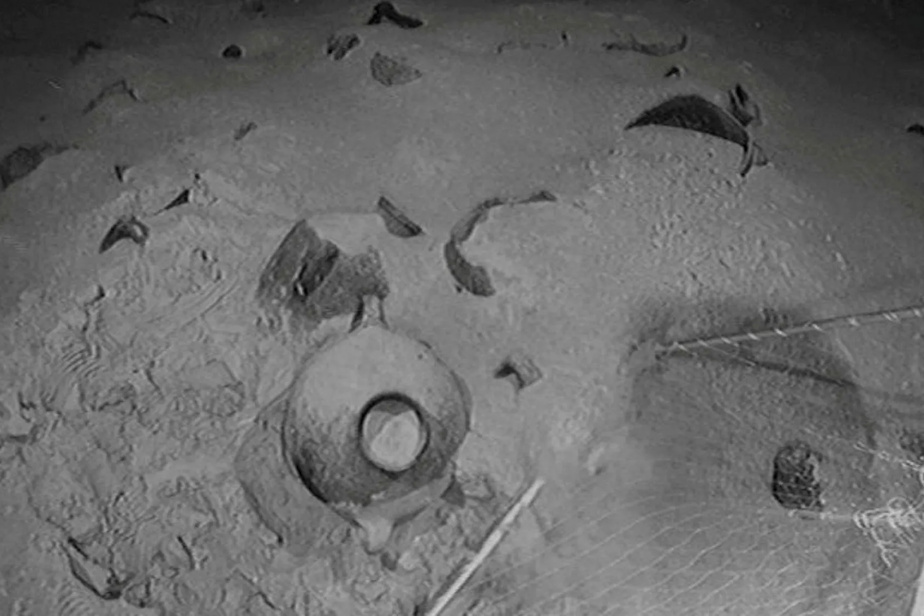The Ice Age in the Gulf of Mexico

PHOTO TAKEN FROM THE UNIVERSITY OF BRADFORD WEBSITE
University of Bradford researcher explores submerged site in Gulf of Mexico
British researchers have identified about 50 pre-Columbian villages submerged in the Gulf of Mexico and are continuing to search for more. The University of Bradford’s Submerged Regions Research Centre, near Manchester, made its name in the field by discovering villages submerged by the English Channel, in a region that, at the end of the Ice Age more than 10,000 years ago, linked England to Europe. Since then, governments in several other countries have commissioned these British specialists to explore their coasts.
The Canaanite Sailors

PHOTO FROM THE ISRAELI ANTIQUITIES AUTHORITY WEBSITE
Two amphorae recovered from 3,300-year-old Canaanite shipwreck
Canaanite seafarers were familiar with long-distance navigation, according to a new discovery off the coast of Israel. It is a shipwreck filled with amphorae that sank 3,300 years ago at a depth of 1,800 meters. The Israel Antiquities Authority said in a statement in June that the Canaanite shipwreck, discovered during gas exploration, shows that sailors of the time could sail away from the coast and navigate using the stars for guidance. The amphorae found are not the work of the Phoenicians, another seafaring people in the region for whom there is more evidence of navigation based on observation of the sky.
Chinese Political Archaeology

PHOTO TAKEN FROM THE WEBSITE OF THE NATIONAL ADMINISTRATION OF CULTURAL HERITAGE
Part of the cargo found in the wreck of a ship that was carrying Chinese exports. The wreck was explored by a robot.
Two Chinese wrecks from the 16th centurye century, discovered in 2022 in a part of the South China Sea claimed by Vietnam and China, have just revealed their secrets. Located 20 km from each other, at a depth of 1,500 m, they offer a snapshot of imports and exports during the Ming dynasty. The National Cultural Heritage Administration (NCHA) said in a statement last June that the cargo of the two wrecks proved that China at the time had “developed and used” the South China Sea. The Middle Kingdom has maritime disputes with many countries in this body of water crucial to international trade.
See the discovery of the two Ming wrecks (in English)
The sinking of tombstones

PHOTO TAKEN FROM THE UNIVERSITY OF BOURNEMOUTH WEBSITE
The tombstones of the 13th centurye century found in wreck off Dorset
A wreck from the 13th centurye century shipwreck found off the coast of Dorset, England, shows the centralization of the funerary industry in the Middle Ages. This spring, archaeologists discovered two elaborate tombstones there, apparently intended for high-ranking prelates. Researchers from Bournemouth University said in a statement that this means the tombstones were carved near the Purbeck marble quarry in Dorset and then shipped to their recipients, rather than being carved on site. The wreck was discovered in 1982.
News from the Antikythera Mechanism…

PHOTO TAKEN FROM THE WEBSITE OF THE NATIONAL ARCHAEOLOGY MUSEUM OF ATHENS
The “Antikythera machine” found in a wreck off the coast of Greece.
For more than a century, a mechanical astronomical clock has intrigued astronomers and archaeologists. The “Antikythera Mechanism,” found in a shipwreck near this Aegean island in 1901, followed a lunar year of 354 days, according to a new Scottish study published in early July in the Horological JournalPhysicists at the University of Glasgow came to this conclusion by extrapolating from marks found on an intact portion of the machine, using methods used in quantum physics.
…and the wreck of Newfoundland

PHOTO TAKEN FROM CLEAN HARBOURS INITIATIVE FACEBOOK PAGE
Wreck appeared in January on a square in Newfoundland
In January, a wreck from the early 19th centurye century, which appeared on a Newfoundland beach, has made headlines around the world. Local historians have suggested that it could be the Lady Sherbrookewhich sank in 1831 with more than 273 souls aboard who were immigrating to Canada. A crowdfunding campaign successfully saved the wreck of the Cape Ray in the spring. A museum in Port-aux-Basques will receive part of the wreck for preservation, and the rest will be placed away from the waves in the provincial park.
